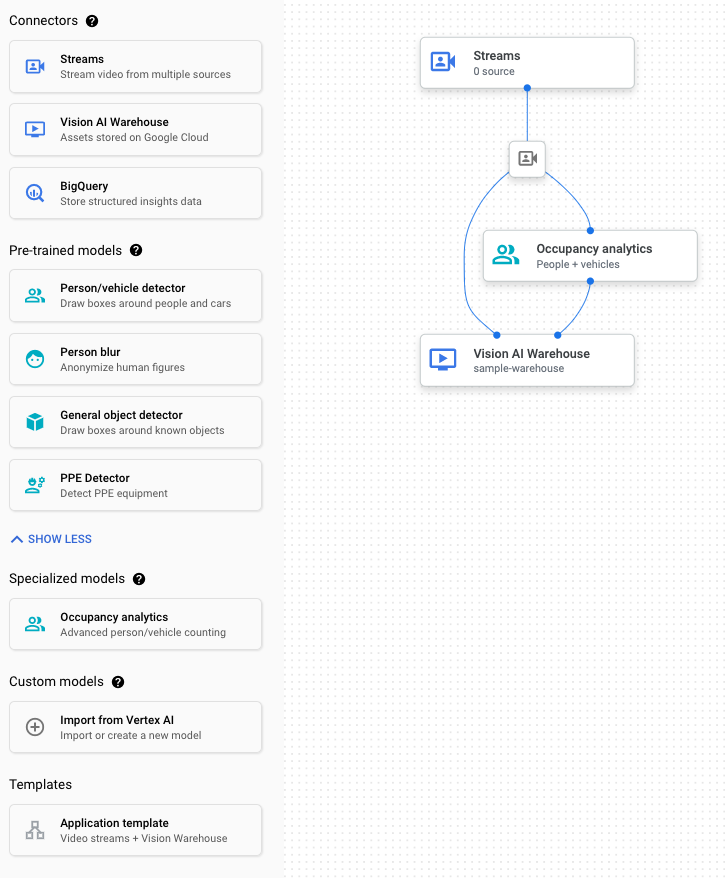Vertex AI Vision è una piattaforma basata sull'IA per importare, analizzare e archiviare i dati video. Vertex AI Vision consente agli utenti di creare e implementare applicazioni con un'interfaccia utente semplificata.
Con Vertex AI Vision puoi creare soluzioni di immagini computerizzate end-to-end sfruttando l'integrazione di Vertex AI Vision con altri componenti principali, ovvero Live Video Analytics, flussi di dati e Vision Warehouse. L'API Vertex AI Vision ti consente di creare un'app di alto livello da API di basso livello, nonché di creare e aggiornare un flusso di lavoro di alto livello che combina più chiamate API singole. Puoi quindi eseguire il flusso di lavoro come unità inviando una singola richiesta di deployment al server della piattaforma Vertex AI Vision.
Con Vertex AI Vision puoi:
- Importa i dati video in tempo reale
- Analizza i dati per ottenere approfondimenti utilizzando modelli di AI visiva generali e personalizzati
- Archivia gli approfondimenti in Vision Warehouse per semplificare le query e le informazioni sui metadati
Flusso di lavoro di Vertex AI Vision
I passaggi da completare per utilizzare Vertex AI Vision sono i seguenti:
Importare i dati in tempo reale
L'architettura di Vertex AI Vision ti consente di eseguire lo streaming dell'infrastruttura di importazione di video in tempo reale in modo rapido e pratico in un cloud pubblico.
Analizzare i dati
Dopo l'importazione dei dati, il framework di Vertex AI Vision ti consente di accedere e orchestrare facilmente un portafoglio ampio e in crescita di modelli di analisi generali, personalizzati e specializzati.
Archivia ed esegui query sull'output
Dopo che l'app ha analizzato i dati, puoi inviare queste informazioni a una destinazione di archiviazione (Vision Warehouse o BigQuery) o ricevere i dati in tempo reale. Con Vision Warehouse puoi inviare l'output della tua app a un magazzino che generalizza le tue ricerche e serve più tipi di dati e casi d'uso.

Una nota sull'IA responsabile
In Google Cloud, diamo la priorità ad aiutare i clienti a sviluppare e implementare in modo sicuro soluzioni utilizzando Vertex AI Vision. Per Vertex AI Vision, ci siamo adoperati per sviluppare un rendimento equo e corretto in conformità con i principi dell'IA di Google.
Questo lavoro include i test per rilevare i bias durante lo sviluppo, ad esempio esaminando il funzionamento su diversi toni della pelle e sviluppando funzionalità dei prodotti per migliorare la privacy e limitare l'identificazione personale, come la sfocatura di persone e volti. Ci impegniamo a eseguire l'iterazione e il miglioramento e continueremo a incorporare le best practice e le lezioni apprese nei nostri prodotti Vertex AI.
Quando Vertex AI Vision viene integrato nel contesto organizzativo unico di un cliente, è probabile che esistano ulteriori considerazioni sull'IA responsabile. Incoraggiamo i clienti a sfruttare le best practice di equità, interpretabilità, privacy e sicurezza durante l'implementazione di Vertex AI Vision, soprattutto quando creano modelli personalizzati o con addestramento AutoML. In questa documentazione tecnica, abbiamo fornito ulteriori indicazioni e risorse per supportare questo lavoro. Per saperne di più, consulta i consigli di Google per le pratiche di IA responsabile.
Passaggi successivi
- Scopri di più nel post del blog "Vertex AI Vision: crea ed esegui facilmente il deployment di applicazioni di visione artificiale su larga scala".
- Scopri i dettagli su modelli specifici nella guida Dati sull'occupazione, nella guida Sfocatura persone, nella guida Rilevamento persone/veicoli o nella guida Applicazione di filtri per il movimento.
- Prova Vertex AI Vision nella Google Cloud console leggendo la guida rapida su come creare un'app nella console.
- Configura il tuo ambiente locale per utilizzare Vertex AI Vision.

